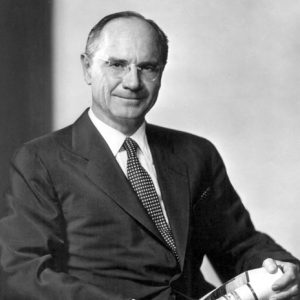calsfoundation@cals.org
James Smith McDonnell Jr. (1899–1980)
James Smith McDonnell Jr. was one of the most significant aerospace industrialists of the twentieth century, building McDonnell-Douglas into the second largest military and commercial aviation corporation in the United States.
James McDonnell was born on April 9, 1899, in Denver, Colorado, to James Smith McDonnell Sr. and Susie Belle McDonnell. The youngest of four McDonnell children, he was raised in central Arkansas. He spent his childhood in Altheimer (Jefferson County), where his parents had one of their two mercantile stores, and he graduated from Little Rock High School in 1917.
Although McDonnell initially leaned toward a career in politics, his father encouraged him to pursue a career more suited to his personality. Completing his BS in physics with honors at Princeton University in 1921, McDonnell attended Massachusetts Institute of Technology’s graduate program in aeronautical engineering before enlisting in the U.S. Army Air Corps Reserves in 1923. Serving one year’s active duty and receiving a second lieutenant’s reserve commission as a pilot, McDonnell began his engineering career in the mid-1920s at the Huff-Daland Airplane Company in New York. His first notable design was a low-winged monoplane dubbed the “Doodlebug,” which he entered in the 1929 Daniel Guggenheim International Safe Aircraft Contest. McDonnell’s design impressed the committee but crashed in trials.
McDonnell planned to open an aircraft firm with the Doodlebug as its first offering. However, McDonnell and his backers found themselves in the same financial crisis as fellow Arkansan John Carroll Cone and the Command-Aire company based in Little Rock (Pulaski County). In an industry filled with boom and bust cycles, McDonnell quickly learned to adapt and survive. After working for a series of companies, including Hamilton Aero and the Glenn L. Martin Company, during the Great Depression era, he went out on his own in 1939.
McDonnell’s first task as head of McDonnell Aircraft was securing financial backing. With World War II looming, McDonnell decided to build his manufacturing base in the Midwest as a safety measure against enemy attack. His close ties to Little Rock almost brought the company to his adopted home state, but St. Louis, Missouri, provided a better package of incentives and banking support. In the atmosphere of wartime production cooperation, the majority of McDonnell Aircraft’s work consisted of doing contracted work for other aircraft corporations. In 1945, McDonnell Aircraft created its own identity by winning the U.S. Navy’s contract to develop the first carrier-based jet airplane, a significant coup in light of the Navy’s considerable ties to the Grumman and Martin companies. This was critical to the company’s survival after the cancellation of subcontracting that came with the end of World War II.
The Phantom was the first in a series of increasingly successful McDonnell jet fighters, particularly utilized by the Navy. Notable early models, including the F-2 Banshee and F-101 Voodoo in the 1950s, preceded the company’s signature aircraft, the F-4 Phantom II, ushering in an era of dominance for McDonnell products. The Phantom II had the rare distinction of being the fighter aircraft of choice of all three American air services during the 1960s. McDonnell Aircraft produced the F-15 Eagle for the Air Force and the F-18 Hornet for the Navy in the 1970s and 1980s.
The key to McDonnell’s success in the volatile aviation industry was balancing the company’s offerings. Two major decisions by McDonnell allowed the company to grow. First, he insisted on expanding into aerospace, positioning McDonnell Aircraft to bid on requests from the government for America’s first spacecraft, the Mercury capsule, in 1959. McDonnell’s prized possession was an autograph from one of the Mercury’s first pilots, John Glenn, describing himself as “a very satisfied customer.” The company provided the Gemini capsule and served as a major contractor for NASA in the Apollo and Skylab programs. Second, McDonnell Aircraft moved into the commercial aircraft industry by merging with the ailing Douglas Company in 1967. The astute maneuvering by McDonnell led to the new McDonnell-Douglas Corporation, which continued the production of two of the industry’s standards in passenger planes, the Douglas DC-8 and DC-9. The engineering experience of the combined companies helped usher in the age of mass air travel with the tri-engine, wide-body DC-10 series.
McDonnell was more than an aerospace innovator, adopting business practices in the 1950s which became commonplace in later twentieth century. Referring to his McDonnell personnel as “teammates” rather than employees, “Mr. Mac,” as he was known, was a personable and well-liked CEO who made conduct a high priority, authoring the company’s nine-point Code of Ethics. One of the quotes most associated with McDonnell was: “We are on this Earth to grow souls.” While much of his personal wealth was created through military sales, he was a staunch advocate of the United Nations and peace efforts around the world. McDonnell Aircraft became the first American company to recognize U.N. Day as a paid holiday.
After guiding his company to become one of the world’s largest aerospace corporations, McDonnell stepped down as CEO in 1972 in favor of his nephew, Sanford N. McDonnell, but he remained chairman of the board until his death in 1980. The year before McDonnell’s death, McDonnell-Douglas had $199 million in sales, $5.3 billion in back orders, $10.9 billion in pending orders, and had a workforce of 125,000. The company continued to flourish for another decade, creating a successful helicopter division through a merger with Hughes Aircraft in 1984. In August 1997, McDonnell’s company itself became a merger victim, absorbed by its primary rival, Boeing of Seattle, Washington (later based in Chicago, Illinois).
McDonnell was married twice and had two sons. He married Mary Elizabeth Finney in 1934, and they had two sons, James S. III and John F. Mary died in 1949, and he married Pricilla Forney in 1954.
Among the honors he received during his career were the 1963 Daniel Guggenheim Medal, the 1966 Collier Trophy, and a 1979 award from the National Academy of Sciences, each presented for his lifelong aerospace work. McDonnell was inducted into the Aviation Hall of Fame in Dayton, Ohio, in 1977 and the International Aerospace Hall of Fame in San Diego in 1981. Locally, he was among the inaugural class of inductees of the Arkansas Aviation Historical Society Hall of Fame in 1980.
McDonnell died at his suburban St. Louis home on August 22, 1980, from the complications of a stroke earlier in the month. James S. McDonnell Hall was dedicated on the campus of Washington University in St. Louis in 1993.
For additional information:
“Flight Pioneer Dies at Age 81.” Arkansas Gazette, August 23, 1980, pp. 1A, 2A.
Francillion, René J. McDonnell Douglas Aircraft. 2 vols. Annapolis, MD: Naval Institute Press, 1979.
Harrison, P. James. Mastering the Sky: A History of Aviation from Ancient Times to the Present. New York: Sarpedon Publishing, 2000.
William M. Smith Jr.
University of Arkansas, Fayetteville
This entry, originally published in Arkansas Biography: A Collection of Notable Lives, appears in the CALS Encyclopedia of Arkansas in an altered form. Arkansas Biography is available from the University of Arkansas Press.


 James McDonnell
James McDonnell  James S. McDonnell Hall
James S. McDonnell Hall 



Mr. Mac was well-respected by his employees. Everyone in St. Louis and surrounding areas knew at least six people who worked at MAC. My dad was a draftsman on the Gemini project, my brother-in-law worked in the Shop, my cousin held top secret ratings, my future husband worked in the Shop, my college roommate worked there after she married, and I worked as a clerk in Bldg. 66 for a while.